
- Average Rating:
- Not yet rated
- Topic Areas:
- Clinical Demonstrations | Reality Therapy | Psychotherapy | Abuse
- Bundle:
- Pioneers of Psychotherapy Bundle
- Categories:
- Pioneers of Psychotherapy | Evolution of Psychotherapy | Evolution of Psychotherapy 1995
- Faculty:
- William Glasser, MD
- Course Levels:
- Master Degree or Higher in Health-Related Field
- Duration:
- 00:59:00
- Format:
- Audio and Video
- Original Program Date:
- Dec 15, 1995
- Short Description:
- William Glasser (1995) demonstrates with a simulated client who is in an emotionally abusive relationship. This client is depressed and unhappy with her life. The goal of the first session is to focus on a behavioral change that can be accomplished as a first step. Glasser concludes with an explanation of the demonstration and of control theory.
- Price:
- $59.00 - Base Price

- Average Rating:
- Not yet rated
- Topic Areas:
- Clinical Demonstrations | Gestalt | Humor | Aging and Mortality | Psychotherapy
- Bundle:
- Pioneers of Psychotherapy Bundle
- Categories:
- Pioneers of Psychotherapy | Evolution of Psychotherapy | Evolution of Psychotherapy 1995
- Faculty:
- Erving Polster, PhD
- Course Levels:
- Master Degree or Higher in Health-Related Field
- Duration:
- 01:04:00
- Format:
- Audio and Video
- Original Program Date:
- Dec 14, 1995
- Short Description:
- Erving Polster (1995) demonstrates with Delisa, who is troubled by her work with geriatric patients. Polster leads Delisa quickly and deeply into her own fears of death and loss. Polster jokes, confronts, and directs Delisa into a greater self-awareness. Following the demonstration Polster explains his work and addresses questions.
- Price:
- $59.00 - Base Price

- Average Rating:
- Not yet rated
- Topic Areas:
- Clinical Demonstrations | Mind-Body | Neuroscience | Psychotherapy | Hypnotic Phenomena
- Bundle:
- Pioneers of Psychotherapy Bundle
- Categories:
- Pioneers of Psychotherapy | Erickson Congress | Erickson Congress 1992
- Faculty:
- Ernest Rossi, PhD
- Course Levels:
- Master Degree or Higher in Health-Related Field
- Duration:
- 01:01:00
- Format:
- Audio and Video
- Original Program Date:
- Dec 02, 1992
- Short Description:
- Rossi (1992) demonstrates his approach to mind-body healing while working with a volunteer, Jennifer, who has rheumatoid arthristis in her hands, which have become distorted and painful. Rossi explains that mind-body healing follows a predictable pattern. During the final phase of this approach, Jennifer begins to experience automatic movement in her hands. She exclaims that her hands are moving more freely than they have in the last five years. Rossi attributes the success to "a genuine moment of self-empowerment."
- Price:
- $59.00 - Base Price
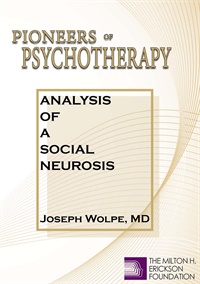
- Average Rating:
- Not yet rated
- Topic Areas:
- Clinical Demonstrations | Psychotherapy | Trauma | Aging and Mortality
- Bundle:
- Pioneers of Psychotherapy Bundle
- Categories:
- Pioneers of Psychotherapy | Evolution of Psychotherapy | Evolution of Psychotherapy 1990
- Faculty:
- Joseph Wolpe, M.D.
- Course Levels:
- Master Degree or Higher in Health-Related Field
- Duration:
- 00:56:00
- Format:
- Audio and Video
- Original Program Date:
- Dec 14, 1990
- Short Description:
- Joseph Wolpe (1990) interviews police officer Tom, who has problems resulting from a traumatic event: he had been confronted by a violent man whom he shot and killed. Later it became evident that the man had an empty gun and was mentally ill. Following a thorough interview, Wolpe uses eye movement and systematic desensitization to diminish the established fear hierarchy.
- Price:
- $59.00 - Base Price
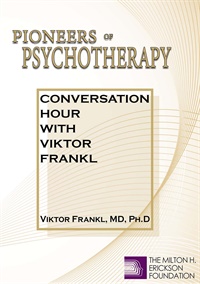
- Average Rating:
- Not yet rated
- Topic Areas:
- Conversation Hours | Existential Therapy | Psychotherapy
- Bundle:
- Pioneers of Psychotherapy Bundle
- Categories:
- Evolution of Psychotherapy | Evolution of Psychotherapy 1990 | Pioneers of Psychotherapy
- Faculty:
- Viktor Frankl, MD, PhD
- Course Levels:
- Master Degree or Higher in Health-Related Field
- Duration:
- 1 Hour 12 Minutes
- Format:
- Audio and Video
- Original Program Date:
- Dec 12, 1990
- Short Description:
- Viktor Frankl (1990) shares his experiences living in a WW-II concentration camp. He teaches the importance of creating meaning in one’s life and the application of ethics in daily choices. He emphasizes the importance of reconciliation in contrast to collective guilt and the importance of finding meaningful responses to all forms of tragedy.
- Price:
-
Evo Stream Subscription is $0.00
price reduced from Base Price - $59.00
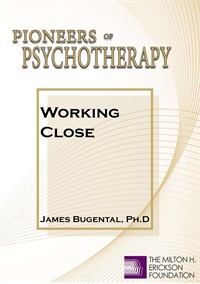
- Average Rating:
- Not yet rated
- Topic Areas:
- Clinical Demonstrations | Psychotherapy | Interviewing | Resistance | Therapist Development
- Bundle:
- Pioneers of Psychotherapy Bundle
- Categories:
- Pioneers of Psychotherapy | Evolution of Psychotherapy | Evolution of Psychotherapy 1990
- Faculty:
- James Bugental, PhD
- Course Levels:
- Master Degree or Higher in Health-Related Field
- Duration:
- 01:00:00
- Format:
- Audio and Video
- Original Program Date:
- Dec 12, 1990
- Short Description:
- Bugental (1990) provides two demonstrations. First, Bugental works with Molly, an associate who is familiar with this approach at an advanced level. Next he works with a naïve client, demonstrating what therapy might look like on the first visit. After each session, Bugental and his client reflect upon his methods.
- Price:
- $59.00 - Base Price
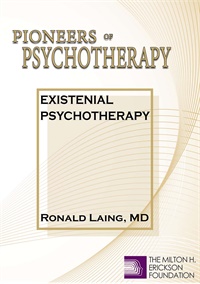
- Average Rating:
- Not yet rated
- Topic Areas:
- Clinical Demonstrations | Psychotherapy | Existential Therapy | Religion | Schizophrenia
- Bundle:
- Pioneers of Psychotherapy Bundle
- Categories:
- Pioneers of Psychotherapy | Evolution of Psychotherapy | Evolution of Psychotherapy 1985
- Faculty:
- Ronald Laing, MD
- Course Levels:
- Master Degree or Higher in Health-Related Field
- Duration:
- 01:11:00
- Format:
- Audio and Video
- Original Program Date:
- Dec 12, 1985
- Short Description:
- Ronald Laing (1985) interviews a home-less woman diagnosed with paranoid schizophrenia. Her presenting complaint is that her brain does not work right and that people are out to get her. Laing relates to the client and explores her theories of human conspiracy, the power of the mind and mind reading, issues of Christianity, and how these concepts relate to her.
- Price:
- $59.00 - Base Price
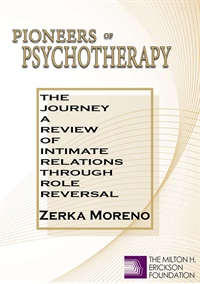
Credit available - Click Here for more information
- Average Rating:
- Not yet rated
- Topic Areas:
- Clinical Demonstrations | Intimacy | Relationships | Psychotherapy | Role Play
- Bundle:
- Women Pioneers of Psychotherapy | Pioneers of Psychotherapy Bundle
- Categories:
- Pioneers of Psychotherapy | Evolution of Psychotherapy | Evolution of Psychotherapy 1985
- Faculty:
- Zerka Moreno
- Course Levels:
- Master Degree or Higher in Health-Related Field
- Duration:
- 01:01:00
- Format:
- Audio and Video
- Original Program Date:
- Dec 12, 1985
- Short Description:
- Zerka Moreno (1985) explains the importance of role reversal. She demonstrates with Lori who discusses concerns related to her marriage. She examines her relationship with her father. Lori is asked to create a family structure using members from the audience. Moreno ends by sharing information about her own experiences in Psychodrama.
- Price:
- $59.00 - Base Price
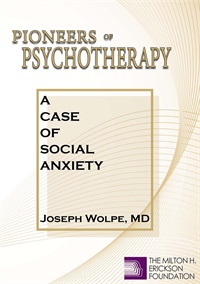
- Average Rating:
- Not yet rated
- Topic Areas:
- Clinical Demonstrations | Anxiety | Psychotherapy
- Bundle:
- Pioneers of Psychotherapy Bundle
- Categories:
- Pioneers of Psychotherapy | Evolution of Psychotherapy | Evolution of Psychotherapy 1985
- Faculty:
- Joseph Wolpe, M.D.
- Course Levels:
- Master Degree or Higher in Health-Related Field
- Duration:
- 00:57:00
- Format:
- Audio and Video
- Original Program Date:
- Dec 10, 1985
- Short Description:
- Joseph Wolpe (1985) begins with Santiago who has a history of experiencing strong feelings of anxiety and discomfort during social situations. Questioning reveals that these problems are most intense when he is in situations in which he experiences a loss of control. Wolpe uses imagery and desensitization to diminish feelings of anxiety.
- Price:
- $59.00 - Base Price
Tags: Anxiety Psychotherapy
Credit available - Click Here for more information
- Average Rating:
- Not yet rated
- Topic Areas:
- Hypnosis | Psychotherapy | Advanced Techniques of Hypnosis & Therapy | Continuing Education | Resistance | Ericksonian Hypnosis and Therapy Techniques | Milton Erickson | Confusion Technique | Naturalistic | Seeding | Hypnotherapy
- Categories:
- Advanced Techniques of Hypnosis & Therapy | Featured | Training Videos | Online Continuing Education | Milton H. Erickson Collections
- Faculty:
- Milton H. Erickson, MD | Jeffrey Zeig, PhD
- Course Levels:
- Master Degree or Higher in Health-Related Field
- Duration:
- 1 Hour 55 Min
- Format:
- Audio and Video
- Original Program Date:
- Dec 31, 1978
- Short Description:
- In 1979, Milton Erickson and Jeffrey Zeig spent five hours reviewing a demonstration that Erickson conducted at a teaching seminar. That demonstration is now available as a training video for Ericksonian practitioners. Erickson’s experiential methods include the symbolic use of hypnotic phenomena, encouraging resistance, naturalistic confusion technique, seeding, and using isomorphic anecdotes. Jeffrey Zeig discusses the mechanics of Erickson’s unique approach to psychotherapy. Working with Resistance provides an opportunity to watch a master hypnotherapist demonstrate his technique.
- Price:
- $75.00 - Base Price
Please wait ...


